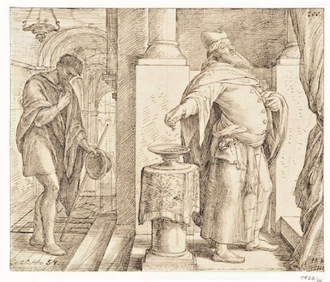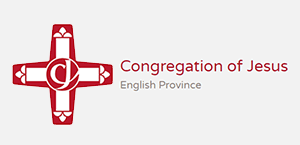Gospel in Art: The Parable of the Pharisee and the Tax Collector

The Parable of the Pharisee and the Tax Collector, by Julius Schnorr von Carolsfeld, Published Leipzig, by Georg Wigands, 1852-1860 © Cologne, Wallraf-Richartz-Museum & Fondation Corboud
Source: Christian Art
Gospel of 29 March 2025
Luke 18:9-14
At that time: Jesus told this parable to some who trusted in themselves that they were righteous, and treated others with contempt: 'Two men went up into the Temple to pray, one a Pharisee and the other a tax collector. The Pharisee, standing by himself, prayed thus: "God, I thank you that I am not like other men, extortioners, unjust, adulterers, or even like this tax collector. I fast twice a week; I give tithes of all that I get." But the tax collector, standing far off, would not even lift up his eyes to heaven, but beat his breast, saying, "God, be merciful to me, a sinner!" I tell you, this man went down to his house justified, rather than the other. For everyone who exalts himself will be humbled, but the one who humbles himself will be exalted.'
Reflection on the Engraving
Our engraving is taken from Die Bibel in Bildern (The Picture Bible) by Julius Schnorr von Carolsfeld, published in Leipzig in 30 parts between 1852 and 1860. Schnorr, a Lutheran, faced criticism at the time for straying too far from the simplicity and severity typical of biblical illustrations. As we see in this engraving, his work carries a certain liveliness-perhaps even a touch of humour-alongside a rich aesthetic and decorative flourish. The scene is striking: the Pharisee stands apart, self-righteous, his prayer echoing the words, "God, I thank you that I am not like other men, extortioners, unjust, adulterers, or even like this tax collector." With an air of indifference, he tosses a coin into the collection tazza. In contrast, the humble tax collector removes his hat, a gesture of deep remorse and humility.
The parable in today's Gospel reading serves as a clear warning about how easily we can become caught up in our own self-satisfaction, measuring our holiness against others and feeling superior. Yet, like those in the parable, we are far from perfect. Jesus calls us to humility; not a false humility that diminishes our worth, but a true humility that recognises our limitations. We are called to use our talents in the service of others, while also acknowledging where we fall short and seeking wisdom from those who know better. Jesus does not ask us to belittle ourselves, nor does He want us to exalt ourselves. He simply calls us to live in truth, recognising our need for God's grace.
Julius Schnorr von Carolsfeld was associated with the Nazarene movement. The Nazarene movement was a group of early 19th-century German and Austrian artists who sought to revive the purity, spirituality, and craftsmanship of early Renaissance and late medieval art, particularly inspired by figures like Fra Angelico and Raphael. Rejecting the academic classicism of their time, they aimed to infuse religious art with deeper emotion and sincerity, often using biblical and historical themes to convey moral and spiritual ideals. Schnorr combined classical compositions with a very expressive, almost theatrical quality. Schnorr's engravings are distinguished by their fine, precise lines and strong contrasts, creating a sense of depth and movement within each biblical scene. Unlike the more rigid and austere biblical illustrations of his time, his work exhibits a dynamic interplay of light and shadow, intricate detailing, and a richness of expression that brings each figure to life.
LINKS
Gospel in Art: https://christian.art/
Today's Reflection: https://christian.art/daily-gospel-reading/luke-18-9-14-2025/ (with audio)


















